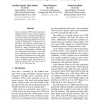Free Online Productivity Tools
i2Speak
i2Symbol
i2OCR
iTex2Img
iWeb2Print
iWeb2Shot
i2Type
iPdf2Split
iPdf2Merge
i2Bopomofo
i2Arabic
i2Style
i2Image
i2PDF
iLatex2Rtf
Sci2ools
NAACL
2010
2010
Contextual Information Improves OOV Detection in Speech
Out-of-vocabulary (OOV) words represent an important source of error in large vocabulary continuous speech recognition (LVCSR) systems. These words cause recognition failures, which propagate through pipeline systems impacting the performance of downstream applications. The detection of OOV regions in the output of a LVCSR system is typically addressed as a binary classification task, where each region is independently classified using local information. In this paper, we show that jointly predicting OOV regions, and including contextual information from each region, leads to substantial improvement in OOV detection. Compared to the state-of-the-art, we reduce the missed OOV rate from 42.6% to 28.4% at 10% false alarm rate.
Binary Classification Task | Computational Linguistics | False Alarm Rate | NAACL 2010 | OOV Regions |
| Added | 14 Feb 2011 |
| Updated | 14 Feb 2011 |
| Type | Journal |
| Year | 2010 |
| Where | NAACL |
| Authors | Carolina Parada, Mark Dredze, Denis Filimonov, Frederick Jelinek |
Comments (0)

